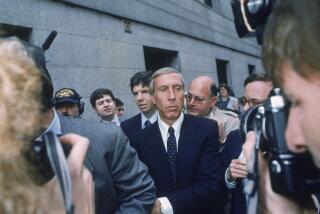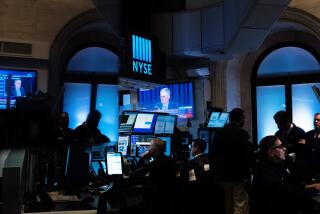Brokerages: Them vs. Us : The big brokers handle large institutional orders by selling or buying from their inventories. In effect, they are now trading against their own customers.
Once upon a time, not so very long ago, the New York Stock Exchange was primarily a service institution for individual investors. When I first went down to write about the place, in the early 1950s, the median trade was for 40 shares. Institutional customers--pension funds, life insurance companies, mutual funds, bank trust departments--accounted for only about 5% of the volume of trading in the mid-1950s. And they paid about the same commissions as ordinary folks.
Some of the trading was done by floor members who bought and sold for their own account as well as executing orders from the public, but the rules of the exchange required them to put customers’ orders ahead of their own. After 1963, the SEC ordered that anyone on the floor who handled a customer order could not buy or sell that stock for his own account the same day.
Today, by contrast, the stock markets are essentially service stations for the big institutions. Trades for 10,000 shares or more constitute more than half the business. On the average, an institutional customer buying or selling that large an order will pay commissions of 8 cents per share, while the individual customer is lucky if he’s charged less than 80 cents per share for his own purchase of a 100-share round lot of a moderately priced stock.
Because they pay so little in commissions, the big funds can play in the games that get all the attention on today’s stock markets--program (computerized) trading, index arbitrage, asset allocation and leveraged buyouts.
Their trading bounces prices up and down during the day to an extent never before known. And the brokerage firms play the same games, operating from screens upstairs rather than through their floor members, which exempts them from the old rules. The annual report of every one of the big houses shows more income from trading for the firm’s own account than it shows from all customer commissions put together.
In effect, the brokers now trade against their own customers. Because the amounts are so large, institutional orders have to be “handled” to minimize their impact on the market. The big brokers handle them by building an inventory of the stocks involved, and meeting their customers’ orders by selling from (or buying into) their own inventory at the closing price of the day.
It is, of course, forbidden for a broker, who is an agent, to buy for his own account ahead of his customer’s order and then sell to the customer at a profit. But the rules do not prohibit firms from acquiring what will become profitable positions in the futures and options markets before executing their customers’ trades--and there are a number of techniques by which friends in the business wash each other’s hands.
The brokers defend their activities as self-defense, arguing that the institutions have driven commissions on large orders so low that nobody can make a living without trading profits. A senior man at one of the largest houses said, “If they want to pay me a quarter a share, I’ll be their agent and get them the best price. If they want to pay me 8 cents, they’ll just have to take their chances in the market.”
The them-versus-us attitudes of brokers and institutional traders produce bad habits in the relations between brokers and their individual customers.
Thirty years ago, relations between broker and customer were personal, with a “customer’s man” at the contact point between the two. He worked for the broker, but it was his standing with his customers that gave him status with his boss. And security, too, because it was commonplace that when a customer’s man moved to another brokerage house his customers moved with him.
Today, in the big houses, the dominant mode is mechanical. There are ads in the telecasts of the Olympics and the World Series, and there are ranks of kids at telephones, selling “investment products” the way you might sell magazine subscriptions. Every effort is made to tie the customer tightly to the firm with IRA accounts, money market funds with check-writing privileges, credit cards and home equity loans that can’t easily be transferred from broker to broker.
In some ways, service is much better. In stocks traded on the regional exchanges, particularly the Pacific Stock Exchange, the small customer’s small order is executed automatically at the market price.
The old-fashioned customer’s man was not always knowledgeable and sometimes not entirely honest, and it was and is not unknown for customer accounts to be “churned,” heavily traded for no purpose other than generating commissions.
Today, too, the computer makes it possible for the customer’s man to keep track of his client’s holdings and positions effortlessly.
Still, the fact is that the same recommendations now go out to virtually all the customers of big brokers from that part of the research department that serves “retail.” Because such recommendations cannot possibly be tailored to the individual financial needs of the customers, they tend to serve the interests of the brokerage house itself.
This is particularly uncomfortable when the firm’s traders are themselves taking positions in these stocks, not infrequently positions opposite to those being recommended to the customers. Hedging strategies are very complicated these days, and there are usually innocent reasons why the firm seems to be trading against its retail customers, but it’s an unpleasant experience to read the fine print at the end of the research report and find your broker has been selling what you’re buying.
What the investor wants today is a real, live person with a sound knowledge of the market who knows enough about his situation to give personal advice and who will say, “I think.” You have to pick a broker by the recommendations of friends and other clients; there is no other way.
Always distrust the fellow who brags about his record, because there’s no government agency or better business bureau to make him keep score honestly. And never be afraid to ask anyone who is advising you on investments to answer questions. If he can’t explain it so you understand it, you shouldn’t do it.
Obviously, there’s a limit to the amount of personal service you can expect from any broker if your account generates only $500 or so of commission revenue every year. Still, the 50 or so “regional brokers” who live off individual accounts are hungry for business these days, now that the extreme volatility generated by the institutions has driven off so many of their old customers.
With today’s data banks and computer communications, the information resources of these firms are in no way inferior to those of the big houses, and the mechanical business of transferring securities and money is now completely automated, so large firms and small offer the same basic services. And the smaller firms don’t “package” their own investment products for sale to customers at big profits to themselves.
A few leaders of the industry, most notably Chairman John J. Phelan of the New York Stock Exchange and his staff, understand that there is a large problem in the mismatch between the General Motors pension fund and the individual investor, and that the ways the brokerage firms have found to profit by that mismatch are bad news for the market and the customers over time.
Among the reforms the exchange has proposed, for example, is revocation of the old rule that size takes priority--that is, if there are 10 orders for 100 shares each and one for 1,000 shares, the 1,000-share order gets filled in its entirety and the others are left hanging there.
This is one of the reasons ordinary people couldn’t get out on Oct. 19, 1987 (or in on the morning of Oct. 20, when investors who thought they saw bargains after the previous day’s catastrophic fall found that the prices they had paid were a lot higher than they were led to expect when they put in the order).
Though the Securities and Exchange Commission hasn’t been helpful in promoting this reform--today’s SEC, like Napoleon’s God, is on the side of the big battalions--its inherent political appeal may pull it through.
About all the public can do at this point is vote with its feet, hunting out the smaller brokers that still prosper by giving service rather than by trading for their own accounts. It’s a service to the country, too, because the more market prices are influenced by the opinion of millions of investors, rather than by the theories of a few hundred supposedly professional portfolio managers, the more likely we are to have efficient markets and rational allocation of capital in this country. We sure don’t have either of those now.
DR, DAN SWEETMAN / for The Times
More to Read
Inside the business of entertainment
The Wide Shot brings you news, analysis and insights on everything from streaming wars to production — and what it all means for the future.
You may occasionally receive promotional content from the Los Angeles Times.










